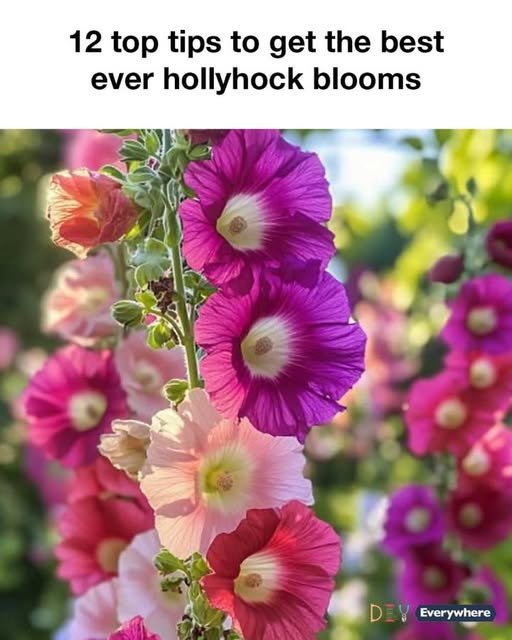Hollyhocks, belonging to the Alcea genus, are classic garden favorites known for their towering spikes and vibrant blooms. These biennial or short-lived perennial plants are cherished for their ability to add vertical interest and a cottage garden charm to any landscape.
Hollyhocks produce large, showy flowers that come in a variety of colors, including pink, red, yellow, and white. The blooms typically appear in the second year of growth, making them a rewarding plant for gardeners who appreciate a bit of patience. Understanding the growth cycle and care requirements of hollyhocks is essential for achieving the best blooms.
Understanding the Ideal Growing Zones for Hollyhocks
Hollyhocks thrive in USDA hardiness zones 3 through 8, making them suitable for a wide range of climates across North America. These plants prefer regions with cold winters, which help to break seed dormancy and encourage robust flowering in the subsequent growing season. In warmer zones, hollyhocks can still be grown, but they may require additional care, such as mulching to retain moisture and protect roots from excessive heat.
Selecting the Right Climate for Optimal Growth
Hollyhocks prefer a climate with cool to moderate temperatures and well-defined seasons. They thrive in areas with full sun exposure, which is crucial for producing abundant blooms. While they can tolerate some shade, too much can lead to leggy growth and fewer flowers. In regions with high humidity, good air circulation is important to prevent fungal diseases.
Choosing the Best Location for Planting Hollyhocks
When selecting a location for hollyhocks, choose a spot that receives at least 6 to 8 hours of direct sunlight each day. Hollyhocks are ideal for planting along fences, walls, or the back of garden borders where their height can be showcased. Ensure the location has well-draining soil to prevent waterlogging, which can lead to root rot.
Preparing the Soil for Healthy Hollyhock Blooms
Hollyhocks prefer rich, loamy soil with a pH between 6.0 and 8.0. Before planting, amend the soil with organic matter, such as compost or well-rotted manure, to improve fertility and drainage. A soil test can help determine if additional amendments are needed, such as lime to raise pH or sulfur to lower it.
Planting Hollyhock Seeds: Timing and Technique
The best time to plant hollyhock seeds is in late summer to early fall, allowing them to establish roots before winter. Sow seeds directly into the prepared soil, covering them lightly with soil. Space seeds about 18 to 24 inches apart to allow for adequate air circulation. Alternatively, seeds can be started indoors 6 to 8 weeks before the last frost date and transplanted outside once the danger of frost has passed.
Watering Hollyhocks: Frequency and Amount
Hollyhocks require regular watering, especially during dry spells, to maintain healthy growth and bloom production. Water deeply once a week, ensuring the soil is moist but not waterlogged. During periods of extreme heat, increase the frequency of watering to prevent stress and wilting.
Fertilizing Hollyhocks for Maximum Bloom Production
To promote vigorous growth and abundant blooms, fertilize hollyhocks with a balanced, slow-release fertilizer in early spring. A second application can be made in mid-summer if growth appears sluggish. Avoid over-fertilizing, as this can lead to excessive foliage growth at the expense of flowers.
Pruning and Deadheading Hollyhocks for Continuous Blooms
Regular deadheading, or removing spent flowers, encourages hollyhocks to produce more blooms throughout the growing season. Use clean, sharp scissors to cut back flower stalks to the nearest set of leaves. In late fall, cut back the entire plant to ground level to prepare for winter dormancy.
Protecting Hollyhocks from Pests and Diseases
Hollyhocks are susceptible to pests such as aphids and diseases like rust. Monitor plants regularly for signs of infestation or disease. Use insecticidal soap or neem oil to control aphids, and remove any infected leaves to prevent the spread of rust. Ensuring good air circulation and avoiding overhead watering can help reduce disease incidence.
Supporting Tall Hollyhock Stems to Prevent Damage
Due to their height, hollyhock stems can be prone to bending or breaking, especially in windy conditions. Provide support by staking the plants with bamboo stakes or garden twine. Tie the stems loosely to the stakes to allow for natural movement while providing stability.
Harvesting Hollyhock Seeds for Future Planting
To collect hollyhock seeds, allow some flowers to remain on the plant until they form seed pods. Once the pods turn brown and dry, carefully remove them and extract the seeds. Store seeds in a cool, dry place in a labeled envelope or container until ready to plant.
Conclusion: Achieving Stunning Hollyhock Blooms
With proper care and attention, hollyhocks can be a stunning addition to any garden, providing height, color, and charm. By understanding their growing requirements and following these tips, gardeners can enjoy a bountiful display of blooms year after year. Whether planted along a fence or as a focal point in a flower bed, hollyhocks are sure to impress with their towering beauty and vibrant flowers.



